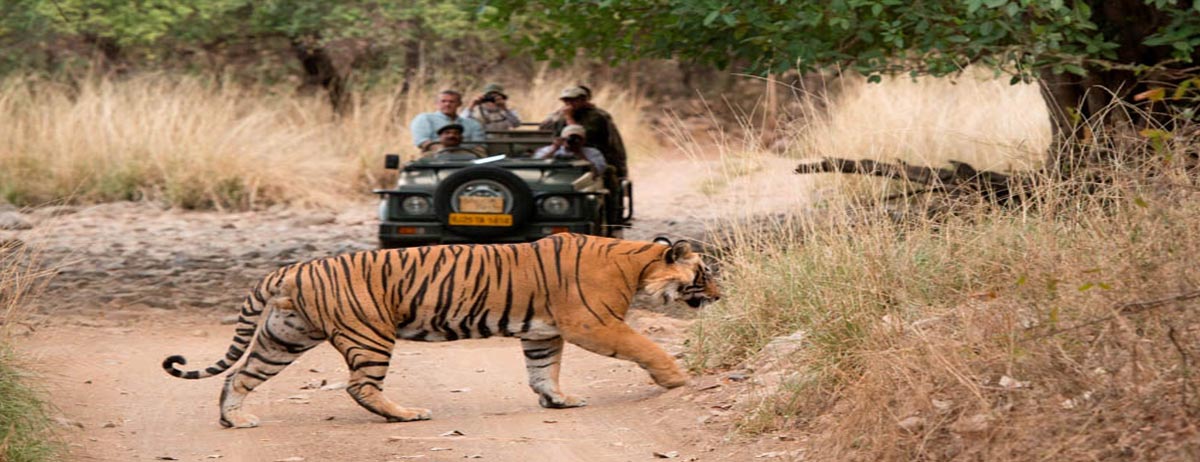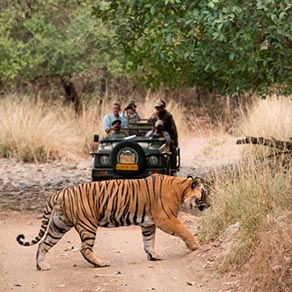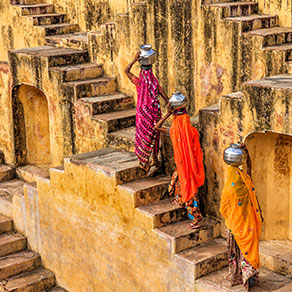Tiger Safaris In India
The majestic tiger, with its striking orange coat and bold black stripes, is not just an iconic species in the animal kingdom but holds a profound place in India’s cultural and ecological tapestry.
As the national animal of India, the tiger has been revered in ancient scriptures, folklore, and even in the daily lives of the people. This reverence, combined with conservation efforts, has set India as the home to the largest wild tiger population globally.
Tiger safaris are an enormously popular component of many Yonder itineraries. Here’s our rundown on the best places to see tigers in the wild, and some essential tips and advice on planning a tiger safari.

Where to see tigers in India
Ranthambore National Park
Located in the Sawai Madhopur district of Rajasthan, Ranthambore National Park stands as one of India’s foremost wildlife destinations. Once the hunting ground for Jaipur’s royalty, it’s now a haven for the Bengal tiger, with a significant population making it a prime spot for tiger sightings. The park’s distinctive landscape comprises dense forests, sharp cliffs, and serene lakes, punctuated by the historic Ranthambore Fort, a UNESCO World Heritage Site. Apart from tigers, the park hosts a diverse range of fauna, including leopards, sloth bears, and myriad bird species, all thriving amidst an atmosphere steeped in history and natural beauty.
Bandhavgarh National Park
Situated in Madhya Pradesh, Bandhavgarh is renowned for its high density of Bengal tigers. The park’s terrain is a mix of grasslands, forests, and rocky hills, crowned by the ancient Bandhavgarh Fort. Historically a royal hunting ground, today, it’s a premier spot for tiger enthusiasts. The park also houses leopards, deer, and diverse bird species.
Kanha National Park
Kanha, in Madhya Pradesh, is often linked with Rudyard Kipling’s ‘The Jungle Book’. Beyond its literary fame, it’s distinguished for conserving the ‘barasingha’ or swamp deer. Verdant meadows and dense forests create a sanctuary for its tigers and other fauna.
Pench National Park
Straddling Madhya Pradesh and Maharashtra, Pench’s verdant landscapes were immortalised in ‘The Jungle Book’ as Mowgli’s home. This vibrant forest shelters a considerable tiger population and is embroidered with rivers and teak forests.
Sundarbans Tiger Reserve
In West Bengal lies the Sundarbans, a UNESCO World Heritage Site. This mangrove-infested delta is known for its swimming tigers, a unique adaptation to its watery environment. It’s a maze of tidal rivers and islands, supporting a rich biodiversity.
Jim Corbett National Park
Located in Uttarakhand, Jim Corbett is India’s oldest national park, established in 1936. Set against the Himalayas, it offers varied ecosystems from grasslands to forests. While tigers are its stars, elephants and diverse avian life make it a wildlife lover’s paradise.
Tadoba Andhari Tiger Reserve
This reserve in Maharashtra boasts of dense forests and serene lakes. A rising star in tiger tourism, Tadoba offers regular tiger encounters and shelters leopards, hyenas, and more.
Kaziranga National Park
Situated in Assam, Kaziranga is famed for its one-horned rhinos. However, its broad grasslands and wetlands also host a high density of tigers, making it a tiger stronghold amidst the backdrop of the Brahmaputra River.
Satpura National Park
Satpura, in Madhya Pradesh, offers a serene, undisturbed wildlife experience. Its hilly terrains and dense forests are home to tigers, leopards, and the Indian giant squirrel. With limited tourist footfall, it promises intimate wildlife encounters.
Nagarhole National Park
Located in Karnataka, Nagarhole is part of the Nilgiri Biosphere Reserve. Tigers, elephants, and a wealth of bird species roam its forests and waterfalls, making it a biodiversity hotspot in southern India.
Tiger safari need to know
When to go on tiger safari
The best time to spot tigers is during the summer months (March to June). As the weather heats up, water sources in the forests dwindle, leading tigers and other animals to congregate around the remaining waterholes, thus increasing the chances of sightings.
The monsoon season (July to September) can be tricky as many national parks and tiger reserves close due to heavy rains and impassable roads.
The winter months (October to February) are also popular for wildlife viewing due to pleasant weather. While tiger sightings might be slightly less frequent than in summer, the overall safari experience can be more comfortable during this period.
Chances of seeing a tiger
While no sighting can be guaranteed, some parks with a higher density of tigers, like Bandhavgarh and Ranthambore, typically offer better odds.
Multiple safaris increase your chances. Typically, tourists go on at least 2-4 safaris during their stay.
Listening to the alarm calls of deer and monkeys can indicate a tiger’s presence. Guides and drivers are usually adept at interpreting these signals.
Trip duration
A typical tiger safari trip, including travel, might take around 3-5 days. This usually allows for multiple morning and evening safari drives, increasing the chances of wildlife sightings. If you’re keen on photography or want a more relaxed pace, consider extending your stay.
Staying safe
Respect the Wild: Always remember that you are in the territory of wild animals. Maintain silence, avoid sudden movements, and do not attempt to attract an animal’s attention.
Stay in the Vehicle: Whether you’re in a jeep or a canter, never disembark during the safari unless instructed by the guide or at designated spots.
Listen to the Guide: The naturalists and guides are trained and knowledgeable about the behaviour of animals. Always heed their advice.
Dress Appropriately: Wear muted colours (greens, browns) to blend in with the surroundings. Avoid bright colours or excessive jewellery.
Health: It’s advisable to carry insect repellent, sunblock, and personal medications.
While tigers generally avoid confrontations with humans, incidents, though rare, can happen. Sticking to the guidelines and maintaining a respectful distance ensures that safaris are both safe for visitors and non-disturbing for the wildlife.
YONDER SUGGESTIONS
Yonder is a specialist India tour operator, including tailor-made, luxury holidays to India which can include any of the must see places discussed in this article.
Previous holidays which we’ve booked include India’s Golden Triangle and Tigers tour, a culture, wildlife and backwaters tour in Kerala and the hidden India Rajasthan tour. These can be great inspiration for your own itineraries.
We can also arrange luxury holidays which explore all the different aspects of India such as our Incredible India tour.
All Yonder itineraries are crafted on a tailor-made, one-off basis, so you can be sure that your holiday will be as individual as you are.
The majestic tiger, with its striking orange coat and bold black stripes, is not just an iconic species in the animal kingdom but holds a profound place in India’s cultural and ecological tapestry.
As the national animal of India, the tiger has been revered in ancient scriptures, folklore, and even in the daily lives of the people. This reverence, combined with conservation efforts, has set India as the home to the largest wild tiger population globally.
Tiger safaris are an enormously popular component of many Yonder itineraries. Here’s our rundown on the best places to see tigers in the wild, and some essential tips and advice on planning a tiger safari.

Where to see tigers in India
Ranthambore National Park
Located in the Sawai Madhopur district of Rajasthan, Ranthambore National Park stands as one of India’s foremost wildlife destinations. Once the hunting ground for Jaipur’s royalty, it’s now a haven for the Bengal tiger, with a significant population making it a prime spot for tiger sightings. The park’s distinctive landscape comprises dense forests, sharp cliffs, and serene lakes, punctuated by the historic Ranthambore Fort, a UNESCO World Heritage Site. Apart from tigers, the park hosts a diverse range of fauna, including leopards, sloth bears, and myriad bird species, all thriving amidst an atmosphere steeped in history and natural beauty.
Bandhavgarh National Park
Situated in Madhya Pradesh, Bandhavgarh is renowned for its high density of Bengal tigers. The park’s terrain is a mix of grasslands, forests, and rocky hills, crowned by the ancient Bandhavgarh Fort. Historically a royal hunting ground, today, it’s a premier spot for tiger enthusiasts. The park also houses leopards, deer, and diverse bird species.
Kanha National Park
Kanha, in Madhya Pradesh, is often linked with Rudyard Kipling’s ‘The Jungle Book’. Beyond its literary fame, it’s distinguished for conserving the ‘barasingha’ or swamp deer. Verdant meadows and dense forests create a sanctuary for its tigers and other fauna.
Pench National Park
Straddling Madhya Pradesh and Maharashtra, Pench’s verdant landscapes were immortalised in ‘The Jungle Book’ as Mowgli’s home. This vibrant forest shelters a considerable tiger population and is embroidered with rivers and teak forests.
Sundarbans Tiger Reserve
In West Bengal lies the Sundarbans, a UNESCO World Heritage Site. This mangrove-infested delta is known for its swimming tigers, a unique adaptation to its watery environment. It’s a maze of tidal rivers and islands, supporting a rich biodiversity.
Jim Corbett National Park
Located in Uttarakhand, Jim Corbett is India’s oldest national park, established in 1936. Set against the Himalayas, it offers varied ecosystems from grasslands to forests. While tigers are its stars, elephants and diverse avian life make it a wildlife lover’s paradise.
Tadoba Andhari Tiger Reserve
This reserve in Maharashtra boasts of dense forests and serene lakes. A rising star in tiger tourism, Tadoba offers regular tiger encounters and shelters leopards, hyenas, and more.
Kaziranga National Park
Situated in Assam, Kaziranga is famed for its one-horned rhinos. However, its broad grasslands and wetlands also host a high density of tigers, making it a tiger stronghold amidst the backdrop of the Brahmaputra River.
Satpura National Park
Satpura, in Madhya Pradesh, offers a serene, undisturbed wildlife experience. Its hilly terrains and dense forests are home to tigers, leopards, and the Indian giant squirrel. With limited tourist footfall, it promises intimate wildlife encounters.
Nagarhole National Park
Located in Karnataka, Nagarhole is part of the Nilgiri Biosphere Reserve. Tigers, elephants, and a wealth of bird species roam its forests and waterfalls, making it a biodiversity hotspot in southern India.
Tiger safari need to know
When to go on tiger safari
The best time to spot tigers is during the summer months (March to June). As the weather heats up, water sources in the forests dwindle, leading tigers and other animals to congregate around the remaining waterholes, thus increasing the chances of sightings.
The monsoon season (July to September) can be tricky as many national parks and tiger reserves close due to heavy rains and impassable roads.
The winter months (October to February) are also popular for wildlife viewing due to pleasant weather. While tiger sightings might be slightly less frequent than in summer, the overall safari experience can be more comfortable during this period.
Chances of seeing a tiger
While no sighting can be guaranteed, some parks with a higher density of tigers, like Bandhavgarh and Ranthambore, typically offer better odds.
Multiple safaris increase your chances. Typically, tourists go on at least 2-4 safaris during their stay.
Listening to the alarm calls of deer and monkeys can indicate a tiger’s presence. Guides and drivers are usually adept at interpreting these signals.
Trip duration
A typical tiger safari trip, including travel, might take around 3-5 days. This usually allows for multiple morning and evening safari drives, increasing the chances of wildlife sightings. If you’re keen on photography or want a more relaxed pace, consider extending your stay.
Staying safe
Respect the Wild: Always remember that you are in the territory of wild animals. Maintain silence, avoid sudden movements, and do not attempt to attract an animal’s attention.
Stay in the Vehicle: Whether you’re in a jeep or a canter, never disembark during the safari unless instructed by the guide or at designated spots.
Listen to the Guide: The naturalists and guides are trained and knowledgeable about the behaviour of animals. Always heed their advice.
Dress Appropriately: Wear muted colours (greens, browns) to blend in with the surroundings. Avoid bright colours or excessive jewellery.
Health: It’s advisable to carry insect repellent, sunblock, and personal medications.
While tigers generally avoid confrontations with humans, incidents, though rare, can happen. Sticking to the guidelines and maintaining a respectful distance ensures that safaris are both safe for visitors and non-disturbing for the wildlife.
YONDER SUGGESTIONS
Yonder is a specialist India tour operator, including tailor-made, luxury holidays to India which can include any of the must see places discussed in this article.
Previous holidays which we’ve booked include India’s Golden Triangle and Tigers tour, a culture, wildlife and backwaters tour in Kerala and the hidden India Rajasthan tour. These can be great inspiration for your own itineraries.
We can also arrange luxury holidays which explore all the different aspects of India such as our Incredible India tour.
All Yonder itineraries are crafted on a tailor-made, one-off basis, so you can be sure that your holiday will be as individual as you are.

 USD
USD


